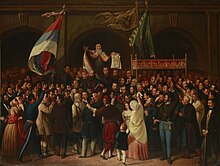Josif Rajačić
Josif Rajačić | |
|---|---|
| Archbishop of Peć, Metropolitan of Belgrade and Karlovci, and Serbian Patriarch | |
 | |
| Native name | Јосиф Рајачић |
| Church | Serbian Orthodox Church |
| Metropolis | Sremski Karlovci |
| Installed | 26 January 1848 |
| Term ended | 1 December 1861 |
| Predecessor | Stefan Stanković |
| Successor | Samuilo Maširević |
| Orders | |
| Ordination | 10 April 1810 |
| Consecration | 20 June 1829 |
| Rank | Patriarch |
| Personal details | |
| Born | Ilija Rajačić 20 July 1785 |
| Died | 1 December 1861 (aged 76) Sremski Karlovci, Kingdom of Slavonia, Austrian Empire |
| Buried | Serbian Orthodox Cathedral of Saint Nicolas in Sremski Karlovci |
| Nationality | Serbian |
| Denomination | Eastern Orthodox |
| Residence | Belgrade (1848–1861) |
| Occupation | Administrator of Serbian Vojvodina |
| Signature |  |
Josif Rajačić (Serbian Cyrillic: Јосиф Рајачић; 20 July 1785 – 1 December 1861), also known as Josif Rajačić-Brinski, was a metropolitan of Sremski Karlovci, Serbian Patriarch, administrator of Vojvodina, and baron.
Life
[edit]Rajačić was born in Lučani, a former village near Brinje in Lika (then Habsburg monarchy, today Croatia). He studied in Zagreb, Karlovci, Szeged and Vienna before dropping out to join the Imperial Austrian Army in 1809 during the War of the Fifth Coalition. On 10 April 1810, he became a monk of the Serbian Orthodox Church in Gomirje Monastery.[1]
On 24 June 1829 he became the Eparch of Dalmatia. On 5 July 1833, he became the Eparch of Vršac. In August 1842, he was named the Metropolitan of Karlovci.[1]
At the May Assembly of Serbs in Sremski Karlovci in 1848, from the balcony of the Sremski Karlovci town hall, he was appointed Patriarch of the Serbs, while Stevan Šupljikac was chosen as the first Duke (Voivode) of Serbian Vojvodina. Apart from being a spiritual leader, Rajačić shared political and military leadership of Serbs at the time of war.[citation needed]

He became administrator of Serbian Vojvodina, and was head of the new Serb government (praviteljstvo) of Vojvodina. Rajačić formed an alliance with the House of Habsburg after being promised autonomy for opposing the 1848 Hungarian Revolution. After the Hungarians were defeated, Rajačić was nominated civil commissioner of Vojvodina by the Austrian Empire.[citation needed]
Rajačić assisted the educational development of the Serb people in the Austrian Empire. In the time when he was metropolitan of Sremski Karlovci, many new Serbian schools were opened. He opened the Patriarchal Library and Print Works. Rajačić spent much of his energy attempting to bring Vojvodina under Serbian administration. On 5 June 1848, on the day of Josip Jelačić's inauguration as Ban of Croatia, Jelačić was appointed Ban in the Patriarch's presence due to Juraj Haulik's current absence from Zagreb.[2]
He was decorated Order of Leopold and Order of the Iron Crown of the first class.[3]
See also
[edit]- Metropolitanate of Karlovci
- Vojvodina
- Rulers of Vojvodina
- History of Vojvodina
- History of Serbia
- Serbian Orthodox Church
References
[edit]- ^ a b Dalmatinska Eparhija 2004.
- ^ Unity, Concord, and Homelands Defence Archived 2007-06-09 at the Wayback Machine, suc.org; accessed 13 April 2015.
- ^ Acović, Dragomir (2012). Slava i čast: Odlikovanja među Srbima, Srbi među odlikovanjima. Belgrade: Službeni Glasnik. p. 77.
Sources
[edit]- Ćirković, Sima (2004). The Serbs. Malden: Blackwell Publishing. ISBN 9781405142915.
- Јован Савковић; Коста Петровић (1954). Патријарх Јосиф Рајачић у Српском покрету, 1848-1849. Државна архива АПВ-е.
- Dalmatinska Eparhija (2004). "JOSIF (Rajačić) patrijarh srpski (1848 - 1861)". Dalmatinska Eparhija. Archived from the original on 2016-11-14. Retrieved 2011-09-01.
- Drago M. Njegovan (2004). Prisajedinjenje Vojvodine Srbiji: prilog političkoj istoriji Srba u Vojvodini do 1921. godine. Muzej Vojvodine. ISBN 978-86-82077-30-5.


 French
French Deutsch
Deutsch







